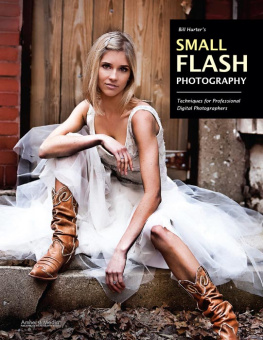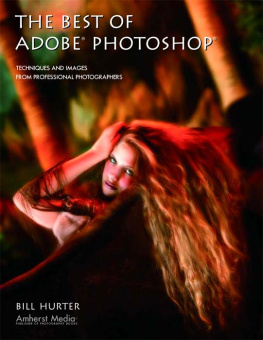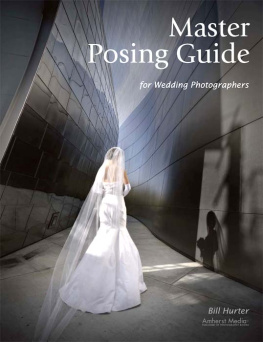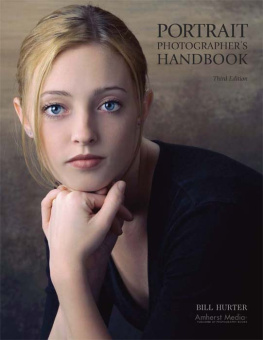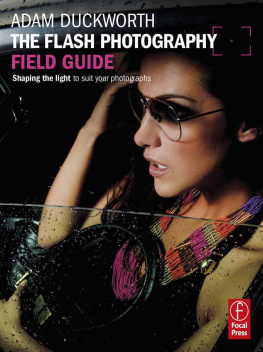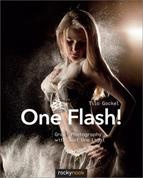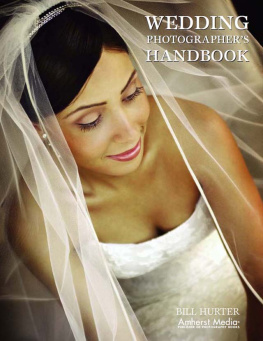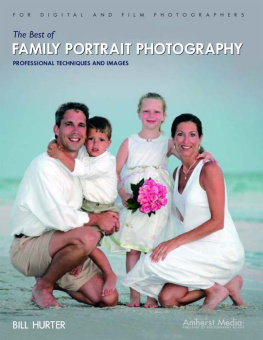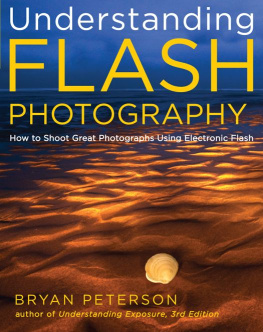Hurter - Bill Hurters Small Flash Photography
Here you can read online Hurter - Bill Hurters Small Flash Photography full text of the book (entire story) in english for free. Download pdf and epub, get meaning, cover and reviews about this ebook. year: 2011, publisher: Amherst Media, Inc., genre: Children. Description of the work, (preface) as well as reviews are available. Best literature library LitArk.com created for fans of good reading and offers a wide selection of genres:
Romance novel
Science fiction
Adventure
Detective
Science
History
Home and family
Prose
Art
Politics
Computer
Non-fiction
Religion
Business
Children
Humor
Choose a favorite category and find really read worthwhile books. Enjoy immersion in the world of imagination, feel the emotions of the characters or learn something new for yourself, make an fascinating discovery.
Bill Hurters Small Flash Photography: summary, description and annotation
We offer to read an annotation, description, summary or preface (depends on what the author of the book "Bill Hurters Small Flash Photography" wrote himself). If you haven't found the necessary information about the book — write in the comments, we will try to find it.
Hurter: author's other books
Who wrote Bill Hurters Small Flash Photography? Find out the surname, the name of the author of the book and a list of all author's works by series.
Bill Hurters Small Flash Photography — read online for free the complete book (whole text) full work
Below is the text of the book, divided by pages. System saving the place of the last page read, allows you to conveniently read the book "Bill Hurters Small Flash Photography" online for free, without having to search again every time where you left off. Put a bookmark, and you can go to the page where you finished reading at any time.
Font size:
Interval:
Bookmark:

About the Author
Bill Hurter started out in photography in 1972 in Washington, DC, where he was a news photographer. He even covered the political sceneincluding the Watergate hearings. After graduating with a BA in literature from American University in 1972, he completed training at the Brooks Institute of Photography in 1975. Going on to work at Petersens PhotoGraphic magazine, he held practically every job except art director. He has been the owner of his own creative agency, shot stock, and worked assignments (including a year or so with the L.A. Dodgers). He has been directly involved in photography for the last thirty plus years and has seen the revolution in technology. In 1988, Bill was awarded an honorary Master of Science degree from the Brooks Institute. In 2007 he was awarded an honorary Masters of Fine Arts degree from Brooks. He has written close to forty instructional books for professional photographers and is currently the editor of Rangefinder and AfterCapture magazines.
Copyright 2011 by Bill Hurter.
All rights reserved.
Front cover photograph by Sal Cincotta.
Back cover photograph by Bruce Dorn.
Published by:
Amherst Media, Inc.
P.O. Box 586
Buffalo, N.Y. 14226
Fax: 716-874-4508
www.AmherstMedia.com
Publisher: Craig Alesse
Senior Editor/Production Manager: Michelle Perkins
Assistant Editor: Barbara A. Lynch-Johnt
Editorial Assistance from: Chris Gallant, Sally Jarzab, John S. Loder
ISBN-13: 978-1-60895-282-3
Library of Congress Control Number: 2010940511
Printed in Korea.
10 9 8 7 6 5 4 3 2 1
No part of this publication may be reproduced, stored, or transmitted in any form or by any means, electronic, mechanical, photocopied, recorded or otherwise, without prior written consent from the publisher.
Notice of Disclaimer: The information contained in this book is based on the authors experience and opinions. The author and publisher will not be held liable for the use or misuse of the information in this book.
| Check out Amherst Medias blogs at: | http://portrait-photographer.blogspot.com/ http://weddingphotographer-amherstmedia.blogspot.com/ |

PHOTOGRAPH BY ANTHONY CAVA.

PHOTOGRAPH BY CHRISTIAN LALONDE.

PHOTOGRAPH BY BEN CHEN.

PHOTOGRAPH BY JB SALLEE.

PHOTOGRAPH BY BRUCE DORN.

PHOTOGRAPH BY JEFF KOLODNY.

PHOTOGRAPH BY CHRISTIAN LALONDE.
O ne major proponent of small flash photography is Christian LaLonde of Photolux Studios in Ottawa, Canada. He has been on board with the technology from the very beginning and has created some amazing shots with multiple Nikon strobesso amazing, in fact, that many of the images shown in this book could not have been made without this technology. He is a big part of this book and my wholehearted appreciation goes out to him for his willingness to share these techniques and theories.
My appreciation also goes out to Bruce Hamilton Dorn of iDC Photography, who wrote me mid-stream and asked if he could help out with my small flash book. Indeed, he didand so a special thanks goes out to him, as well.
JB Sallee also contacted me about the book on the same day as Bruce Dorn and asked if he could contribute. He contributed not only images but also diagrams of each image he shot with small flash. Excellent! Thanks to you, too, JB.
Also, thanks go out to Ben Chen. When he found out I was working on a small flash book, he started capturing lighting setup shots on his more interesting speedlight photography assignments.
Thanks, as well, to all of the other photographers who helped me put this book together. It wouldnt have been possible without your talent.
T he new flash is small flashand it has become king. In recent years, small flash has been widely popularized by people like David Hobby, the founder of strobist.com (a leading photography web site that is devoted to small flash and its many applications), as well as Joe McNally and Lou Jones, both small flash aficionados and authors of popular books on the subject.
So why is small flash so popular among todays professional photographers? Well, first, because studio flash (a.k.a. big flash photography) is expensive, not particularly mobile, and ill-suited to really small areaslike nooks, crannies, and the back seats of sports cars.
Additionally, small flash photography is done without modeling lights, which essentially made it impossible before the advent of the DSLRs instant-preview LCD. With film, you had to do the math (sometimes exceedingly difficult math) in your headcalculating distance to the subject, factoring in the reflectivity of the subjects and environs, and taking into account a myriad of other factors. Now, all you have to do is to check the LCD screen and say, Whoops. Id better give that one a stop more exposure. The times have decidedly changed.
Small flash has the added advantage that it can be controlled via the cameras LCD. Because of WiFi technology, and the camera makers'specifically Nikonsingenious engineering of TTL units, multiple small flashes can now be completely controlled from the camera.
The result is nothing short of amazing, as you will see throughout this book.

Nikons SB-700 looks like an off-the-shelf, modest electronic flash unit. However, reviewing the specs reveals that it represents a benchmark for all who want to do creative small flash photography.
While it is not the province of this book to recommend a specific small flash unit that will be the perfect flash for you, it can be helpful to look at what you can expect from a pretty good small flash. Well look at one that has recently been introduced by Nikon: the SB-700. This is not the top-of-the-line flash unit (that would be the SB-900), but an all-around performer with great specs and great system compatibility.
First, however, we should consider the value of using a dedicated flash (one designed by your cameras manufacturer to work with your camera) as opposed to third-party flash units. For your primary flash, a dedicated unit offers significant advantages: it will incorporate all of the technology that went into the camera design and it will speak the right language to communicate seamlessly with your camera. In the old days, a Vivitar 283 would do the trickjust pop it on the hot-shoe and off you merrily go! Today, the powerful ways in which camera manufacturers have dedicated their TTL flash units to work with their DSLR camera systems cannot, in this writers opinion, be duplicated by third-party units. Where third-party flash units
Font size:
Interval:
Bookmark:
Similar books «Bill Hurters Small Flash Photography»
Look at similar books to Bill Hurters Small Flash Photography. We have selected literature similar in name and meaning in the hope of providing readers with more options to find new, interesting, not yet read works.
Discussion, reviews of the book Bill Hurters Small Flash Photography and just readers' own opinions. Leave your comments, write what you think about the work, its meaning or the main characters. Specify what exactly you liked and what you didn't like, and why you think so.

